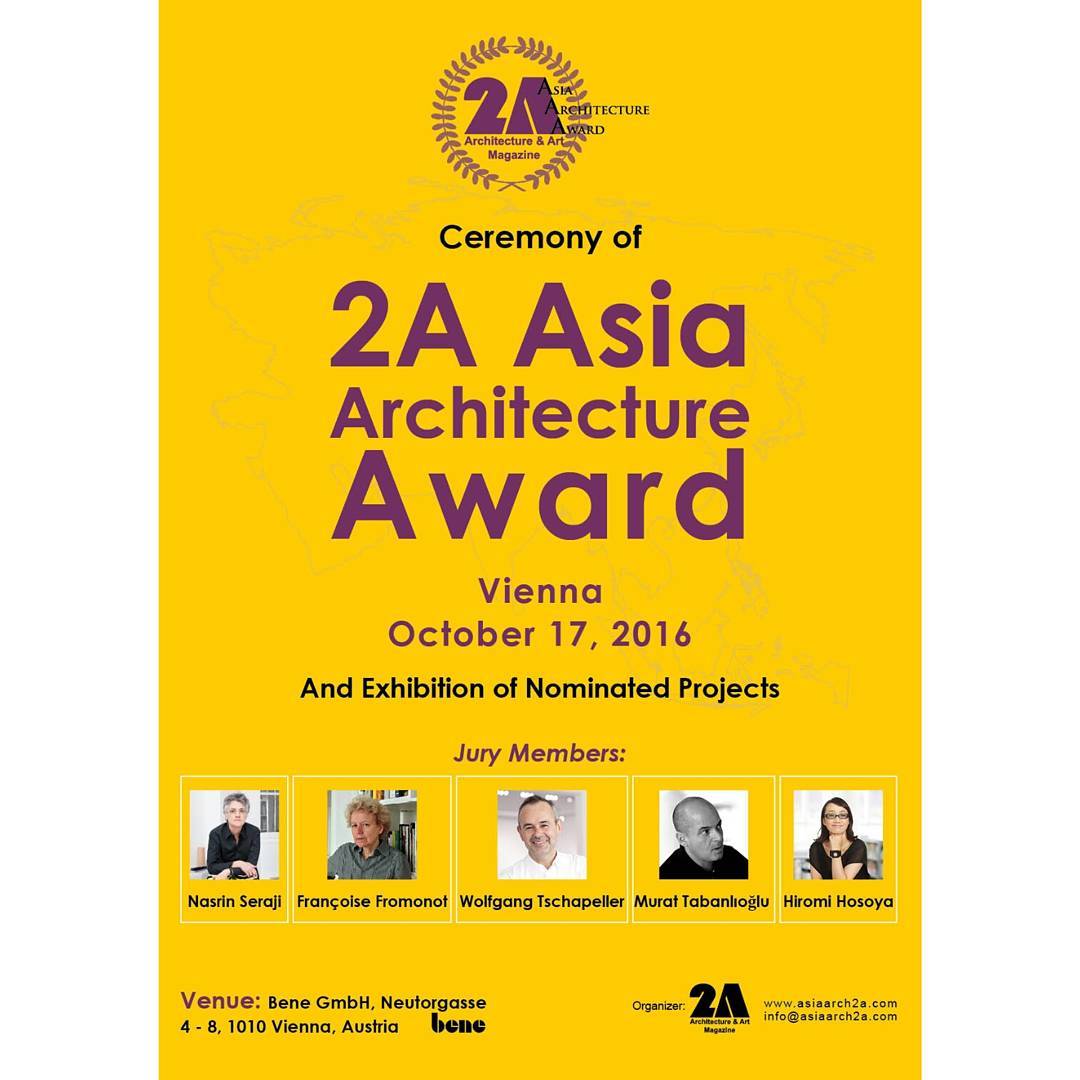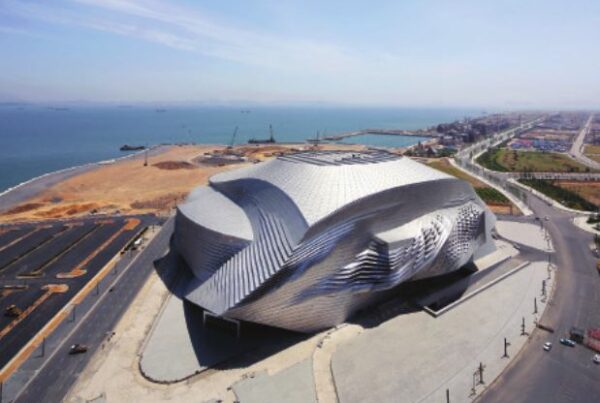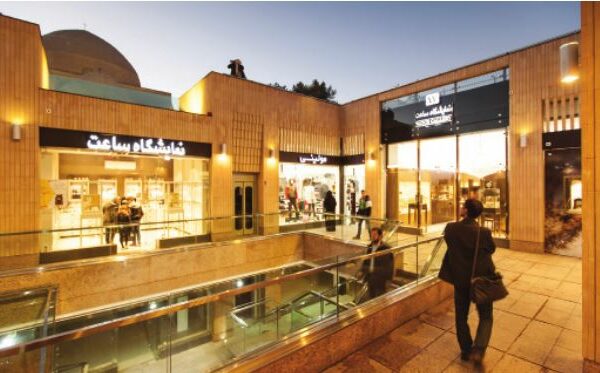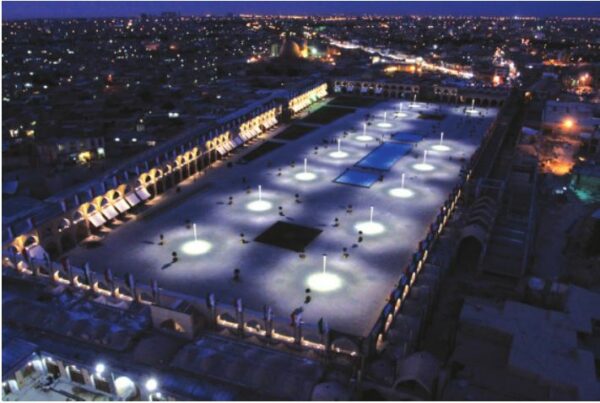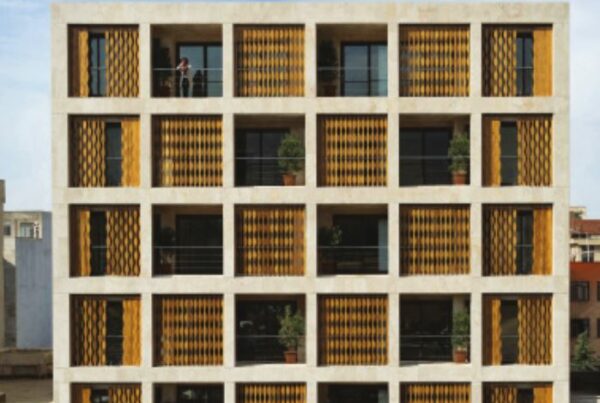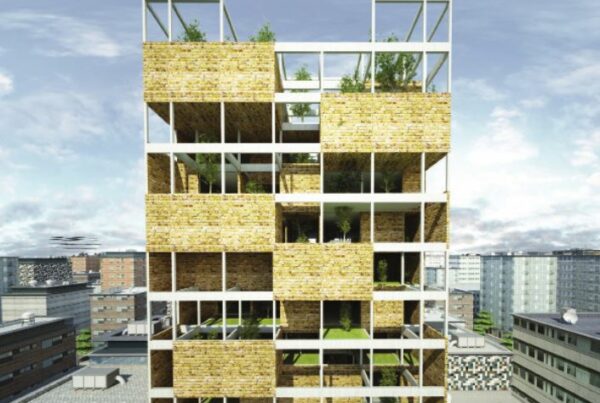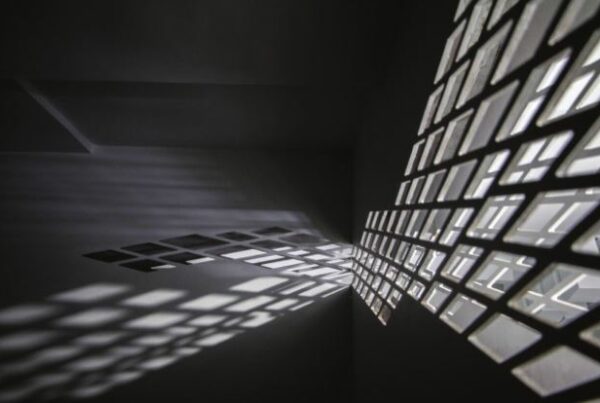2A Asia Architecture Award 2016
The 2A Asia Architecture Award 2016 Jury and ceremony was held in Vienna 15-17th of October 2016, in cooperation with the Academy of Fine Arts Vienna (which celebrates its 325th anniversary this year). This was the second round of the Award since its inauguration in Istanbul 2015. The following text is a brief report of the 2AAA 2016:
Jury Members
Françoise Fromonot
Biography: Françoise Fromonot is an architect by training, an architecture critic, currently Professor at the schools of architecture of Paris-Belleville (History, Theory and Design) and of Rice University, Houston (Paris programme). She was contributing editor of l’Architecture d’Aujourd’hui (1994-1998), co-editor in chief of the journal le Visiteur (1999-2003), and, in 2007, a founding member of Criticat. Her extensive writings include monographs on Glenn Murcutt, Jørn Utzon, Marc Mimram, as well as numerous critical writings on contemporary urbanism.

Nasrin Seraji
AA dipl RIBA
– Dean of the École Nationale Supérieure d’Architecture Paris-Malaquais
– Professor of Ecology, Sustainability and Conservation, as well as Head of the Institute for Art and Architecture, Academy of Fine Art in Vienna through to 2012
– Professor and Chair of the Department of Architecture at Cornell University from 2001 to 2005
– She received the medal for Chevalier des Arts et des Letters from the Minister of Culture in France (2006) for her role as an architect contributing to excellence in art and humanities
At the present: head of Architecture School in Hong Kong

Wolfgang Tschapeller
– Master in Architecture from Cornell University in Ithaca, NY
– Professor of architecture at the Academy of Fine Arts in Vienna and as of 2012 he is the head of the Institute of Art and Architecture
Contributions to the exhibition New Trends of Architecture in Europe and Asia-Pacific 2008 in Tokyo and 2010 in Istanbul, as part of the exhibition Sculptural Architecture in Austria at the National Art Museum of China in 2006

Murat Tabanlıoğlu
RIBA, Chartered Member, Int’l. Assoc. AIA
– studied architecture at Vienna Technical University and graduated in 1992. He founded Tabanlıoğlu Architects in cooperation with Dr. Hayati Tabanlıoğlu in Istanbul in 1990
As a jury member, in addition to his national and international contributions, such as at AIA and WAF, Mr. Tabanlioglu serves on the Master Jury for the 2013 Cycle of the Aga Khan Award for Architecture

Hiromi Hosoya
Partner of the Zurich-based architecture, urban design, and research firm Hosoya Schaefer Architects, founded with Markus Schaefer in 2003. She received her Masters in Architecture from Harvard University and has since directed design studios at several universities, including the GSD. Hosoya Schaefer has won numerous international awards and is completing a broad spectrum of projects, including the Hafen-City in Hamburg, the Swiss National Exposition 2027, and the Swiss National Innovation Park.
Editorial ( Published in 2A magazine issue #36)
Ahmad Zohadi
Broad Objectives of the Award
The 2016 2A Asia Architecture Award was an open award for anyone in the national or international architectural community who had designed or built a project in Asia during or after 2001. The award announcement was published broadly in numerous architecture publications and other media outlets in order to invite individuals or groups to participate.
The theme of this year’s award was “Theme: Innovative Architecture in Asia.” Accordingly, the Award recognized an individual or group’s substantial contribution to today’s architecture in Asia in terms of contemporary challenges in the field and region, which had a lasting influence on the theory and practice of architecture.
Detailed Judging CriteriaThe organizing committee set up a two-stage judging process and detailed judging criteria based on the award announcement. These were distributed to the jury members to solicit their feedback.
1- Criteria for all categories except interior and urban design:
– Reflection of sense of place, ecology, environmental sustainability, and cultural identity
– Social responsibility, community, and urban connectivity
– The effects of economic conditions on the project
2- Criteria for urban projects
– Design achievement
– Contextual analysis and study
– Reflection of sense of place, ecology, environmental sustainability, and cultural identity
– Social responsibility, community, and urban connectivity
– The effects of economic conditions on the project
3- Criteria for interior projects
– Design achievement
– Technical advancement, including engineering achievements (construction detail, structural, mechanical, etc.)
– Innovative use of materials and experimentation with new materials
– Reflection of sense of place, ecology, environmental sustainability, and cultural identity
– Social and economic responsibility
Judging Process
The award review had a three-stage process, the: pre-review, blind review, and discussion review.

Figure 1: The two-stage judging process conducted subsequent to the pre-review
Pre-review Process
402 projects were registered online. At this stage, all submitted projects went through a technical review to verify that they met the award standards. To maintain the quality of entries and ensure the required documents, all submissions were required to go through this pre-review stage. Out of 402 submitted projects in seven categories, 358 projects met the award submission standard and were qualified to be reviewed by the jury.
Blind Review with Online Scoring
In this stage, jury members were asked to assess two PDF files and a project description for each entry, and score them based on the general goal of the prize. The purpose of the contest was to locate and highlight contemporary urban, landscape, and architectural works in Asia whose innovative characteristics epitomized the Search for Asian Spirit in Architecture, and who contributed to a new direction and order for Asian cities. Based on the judging criteria, each project could receive a score from 1 to 10. Each was reviewed and evaluated with other projects in the same category. Although the majority of the evaluation criteria were common among all categories, each category’s submissions were evaluated separately.

Discussion Review in Vienna
In this final stage, award winners were selected based on a selective basis. All of the jury members had copies of the competition criteria and reviewed the projects accordingly. During the deliberations, selection decisions were made in several rounds and by voice vote. Each jury determined its own voting procedures. More important than the tally procedure, though, was the exchange of views taking place during the jury’s deliberations. The final decisions evolved from that dialogue.
Participants from 24 Asian countries
Projects from 2001 – 2016
The acceptance rate of the projects in pre-review stage: 89%
The acceptance rate of the projects in 2nd stage judgment: 16%
The average acceptance rate of the 2016 2AAA: 6%
Some points have been derived from Negar Kalantar’s article in 2A magazine issue #33 & 34

2AAA jury board meeting and ceremony, Vienna – October 2016
Part 2: 2A Continental Architectural Awards:
Beyond the obvious professional architectural advantages and characteristics, the Continental awards is hoping to help enhance Peace, Compassion and Unity around the world:
Any form of art like architecture have a magical quality which may be subtle and invisible to many people. It has the power to help both the artists and its observers to shift their attention and viewpoints from the material to more subtle esthetic, ethical, social, cultural and sometimes spiritual dimensions, and in doing so it helps to bring people closer together, and enhance peace, kindness and unity among different ethnic groups and nations. In a way, it shifts the focus from segregation to unity. From dividing mental approach which may focus only on differences which tries to show one group is superior to another, into a more humanistic and even spiritual approach which focuses on similarities and unifying factors such as esthetic, common human emotions such as need to love, charity and worship.
2A Magazine as organizer of 2A Continental Architectural Award hopes to achieve a broader goal, which is by bringing architects who are also creative artists, together and providing an opportunity for sharing and interacting ideas, help enhance peace, friendship, and disseminate the wave of unity, friendship and peace around the world.
Meeting this goal, 2A magazine will take another step towards creating a forum for all architects around the Globe to expand and enrich their vision about architecture.
Nasrine Seraji
It was in the month of October 2016 when we gathered in Vienna to discuss the prizes of the 2A magazine. What is 2A and why Vienna?
2A is an International Magazine, which promotes intelligent, comprehensive and innovative architecture practices in Asia. Vienna is considered to be the turning platform between eastern and western Europe. For Long this city has allowed for many negotiations to happen, be it political, economical or even within the arts. It has also been the city of radical thought, attracting some very important artists and architects in the past and even recently. Where better than the Academy of Fine Arts, where the likes of Otto Wagner and Peter Behrens, Peter Sloterdjk or even Harun Farocki more recently, contributed to the foundations of architectural and art education?
I was approached by the organisers to take part in the “grand prize” of the magazine as a jury member, having spent eleven years of my teaching life in Vienna. I was delighted to be able to contribute once again to the debate on architecture. However I was not expecting to be elected as the president of the jury and have the task of writing an article on this very rich experience.
But then, here we are!…
It was an honour and a great challenge to work with an international team of architects, academics and critics from Turkey, Japan, Iran, France, and Austria. The variety of the projects from interior design, to urbanism and large-scale public spaces passing through, residential projects, public schools, and unrealised projects made the task both difficult as well as stimulating.
When projects vary in scale and are situated in different countries such as Iran, Bangladesh, China, Japan, Turkey, India, Korea etc… the jury needs to construct a set of viable criteria through which it considers the various contributions, as well as allowing for the finalists to propose what architecture needs to address in our societies.
The jury had some very in depth discussions on topics such as economy, social and programmatic challenges that architects are faced in these countries. The shortage of material, the political and economical diversity and the need for architecture that assumes a certain image of progress and technical literacy made the task of comparison and judging evermore challenging.
As much as we are part of a global network and the planet seems to have similar concerns such as climate change, water shortage, material scarcity and economical disparity, architecture tends to remain a very local discipline. It is still tied to the local systems of economy, material and building technologies. Though some of the production ignores the relevance of site and its specificities, concentrating on parametric and formal concerns, there is still a huge number of architects who seem to still believe in the idea that architecture matters. Although most of the projects we looked at used very different building techniques, had different budgets and varied programmes, we managed to have a set of criteria with which we could compare the vast number of projects submitted.
Some of these criteria were the pertinence with which the project was adding quality of life to the place and culture that it was built. The beauty and elegance of the work in relationship to the given programme and budget, the capacity of the project to create a contribution and discussion to the greater debate of architecture…
We managed to extract the quality of each project related to its production conditions and the means with which the architects had managed to contribute to the site, the landscape or the city where it was situated.
The discussion on the projects and their presentation was also a central theme of the jury. Most of the projects were images of moments in the buildings very few projects had the proficiency and dexterity to simply describe and illustrate the main concerns and ideas of the projects. The urban projects were very difficult to understand. I had seen some of the projects and therefore could describe them but otherwise it was very difficult to understand the main axis of thinking through the drawings and the panels presented.
It seems that the architecture discipline is travelling through a major crisis; the difficulty of illustration and description of complexity is leading to tools that are more about management than inscription, narration and authorship. Is the timeless, scale-less world of digital production the reason for this? Are we all to be collective authors? We don’t know but there is one thing that is certain; that architects need to reinvent how to tell their stories.

Nasrin Seraji, head of jury members in 2A Asia Architecture Award
The 2016 2A Asia Architecture Award Winners
2A magazine is pleased to announce the final winners of 2A Asia Architecture Award 2016 (2AAA 2016). Under the organization of 2A magazine – Ahmad Zohadi (CEO of 2A magazine and chief organizer of the award) and Golmar Mina Khatibi (member of organizing committee of 2AAA 2016). The 2016 jury, Wolfgang Tschapeller, Murat Tabanlıoğlu, Nasrin Seraji, Françoise Fromonot and Hiromi Hosoya decided on the winners for each category in a jury panel took place in Academy of Fine Arts Vienna.
This year’s 2AAA took place in two stages. The First Stage Entry started at July 1, and with extension days, closed on August 3, 2016.
The response to the Call for the submission was very strong. Out of 400 submitted projects in seven categories, around 358 projects have been met the award submission standard in the first stage.
During August 2016, the entries from 7 categories, have been reviewed and assessed by Jury and with respect to the award main goal which is defined as:
To identify essences of Architecture in Asia and to glorify the importance of social and cultural identity and significance of spirituality along with physical aspects of architecture.
The competition sought to award individuals or teams that have demonstrated the closest idea/architecture to the main award goal with respect to defined Judging Criteria, as follows:• Design Achievement
• Contextual Analysis and Studies
• Technical Advancement
• Innovative Use of Material
• Reflection of Sense of Place and Ecology (Environmental Sustainability)
• Reflection of Cultural Identity
• Social Responsibility and Community and Urban Connectivity
• Effects of Economical Condition
160 projects received the accepted score in 7 categories and invited to submit final boards for the second stage judgment and the exhibition. At second stage, short listed printed boards were presented in and discussed by the jury board on October 15, 2016 in Academy of Fine Arts Vienna.
At the second stage judgment, based on the award criteria each jury selected three projects from each category, and jury members discussed their defends for their selections. The total number of 39 projects out of 160, were selected at this process.
The final stage judgment done by voting to the projects, and based on the numbers of votes had been received, three projects were recognized as first, second and third places respectively. Also in categories of public & old and new two projects selected as special acknowledgment.
Finally 23 projects were selected as winners of 2A Asia Architecture Award 2016, and awarded at the ceremony.
2A Asia Architecture Award Ceremony:
With presence of many architects of nominated projects, jury members, organizing committee and some well-know international architects, Category winners were announced and awarded publically at the award ceremony on Monday October 17, 2016 at Bene GmbH, Vienna.
Public
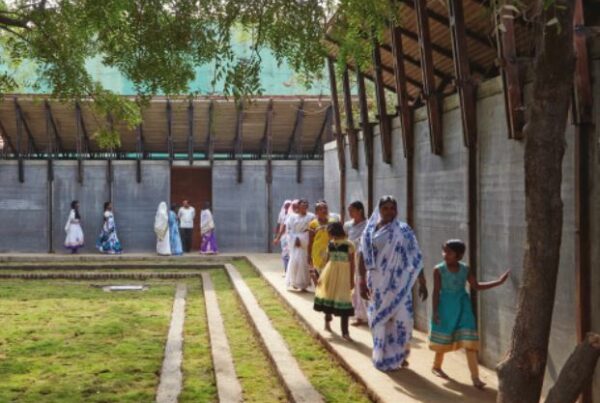
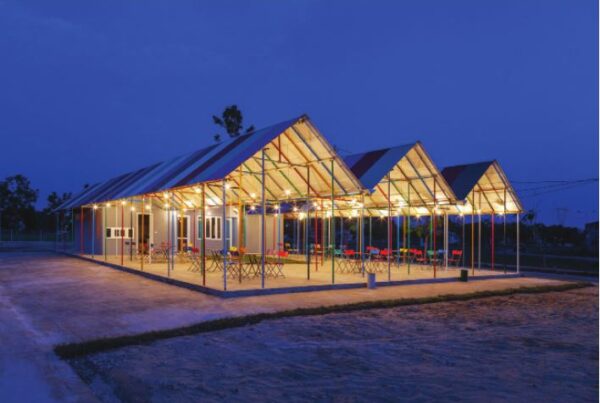
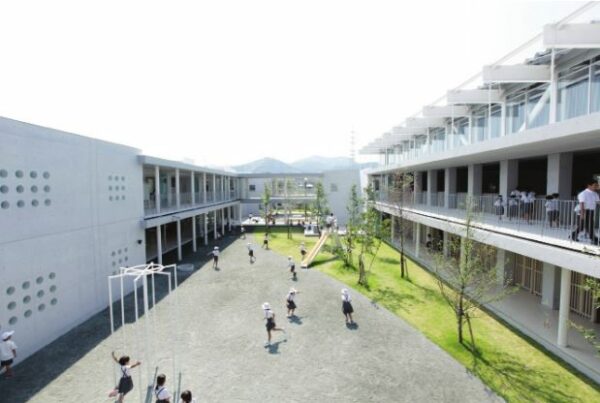
Commercial
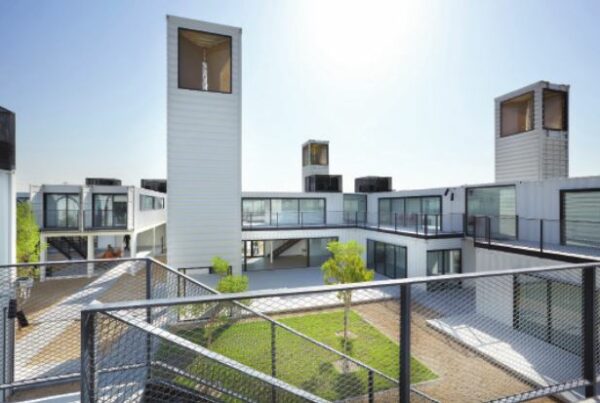
Old and New
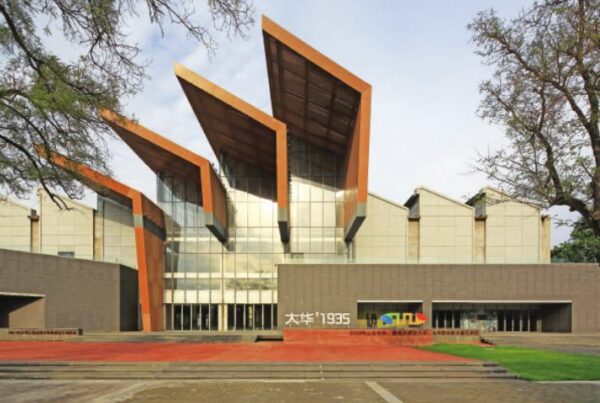
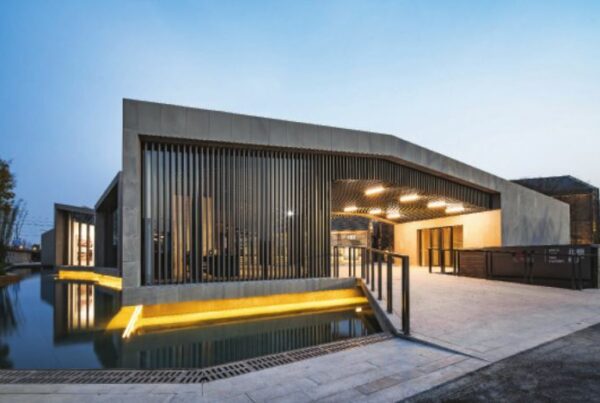
Residential
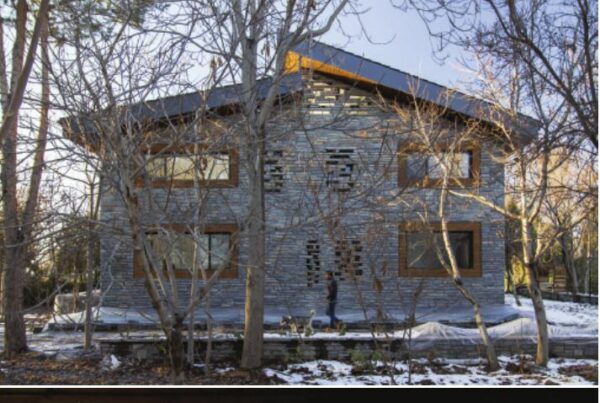
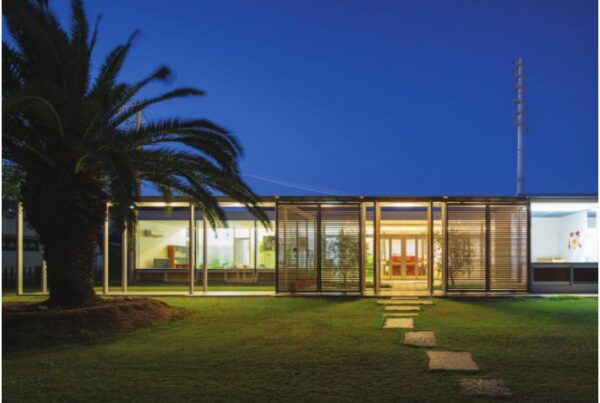
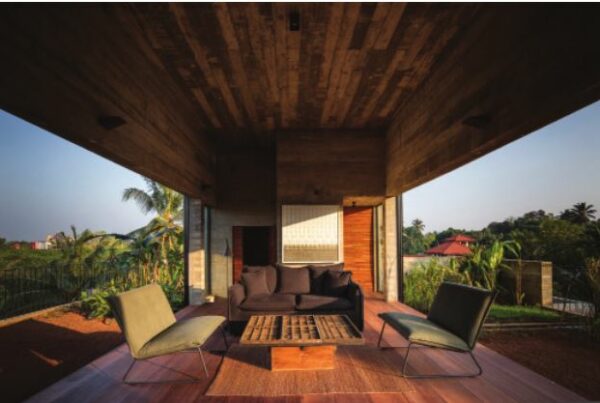
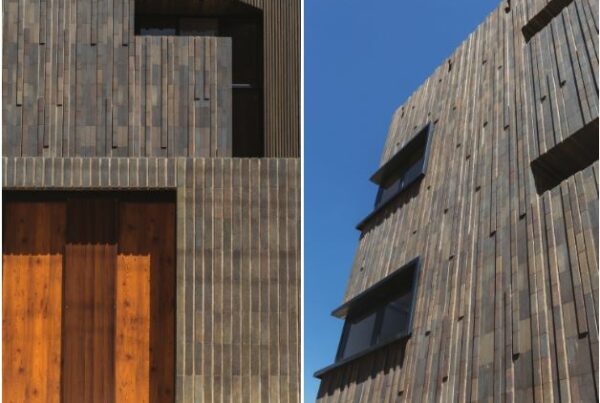
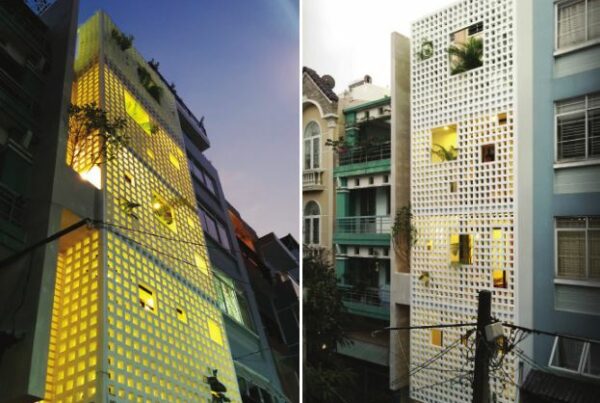
Urban, Rural Projects
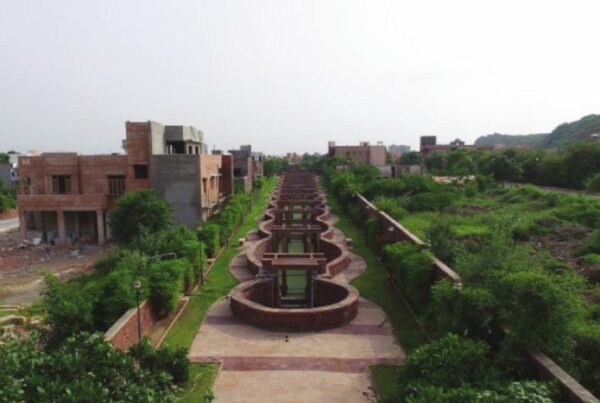
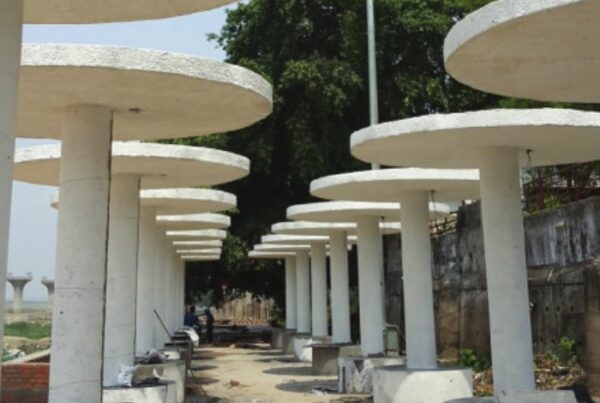
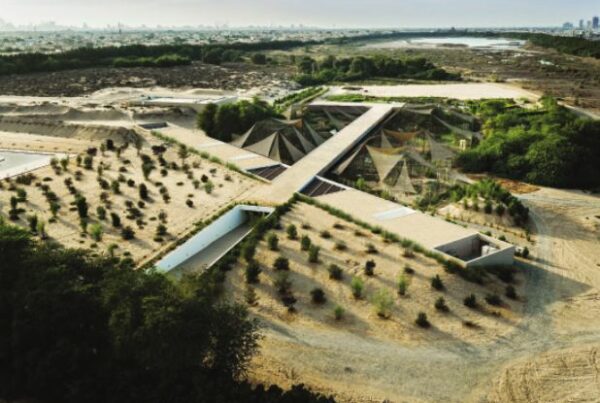




Future
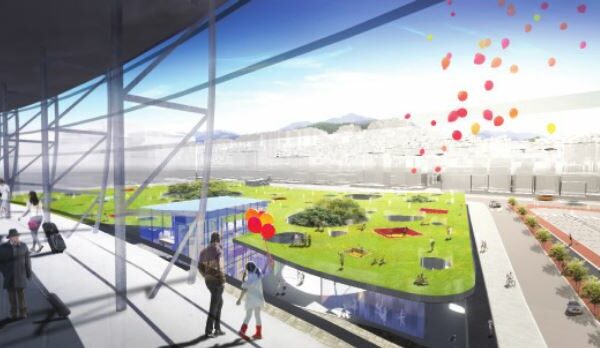
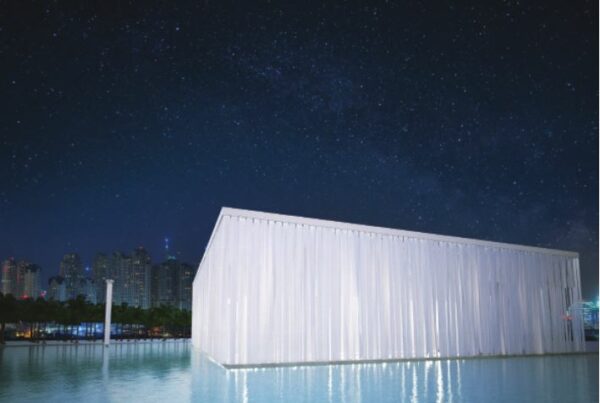
Interior Architecture
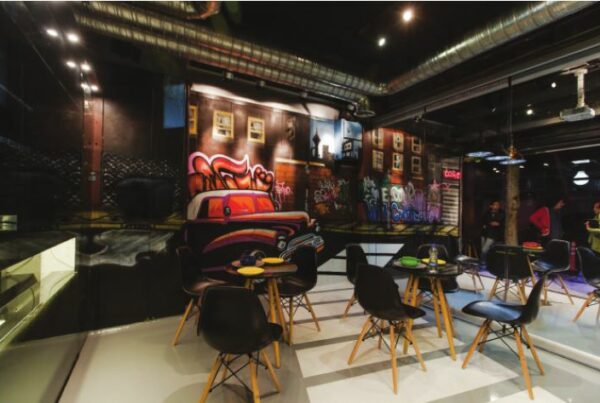
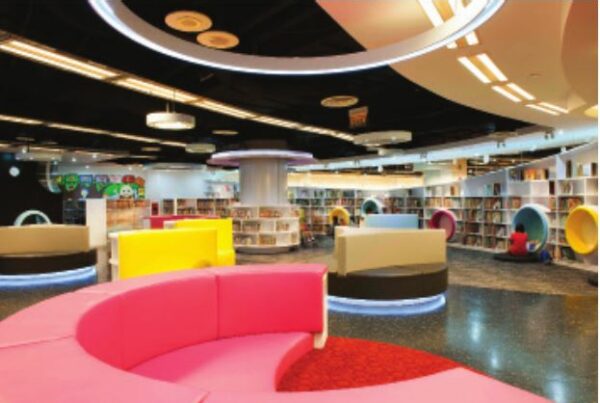
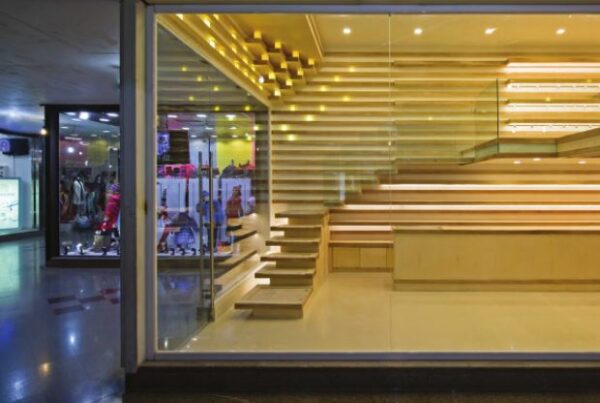
Organized by
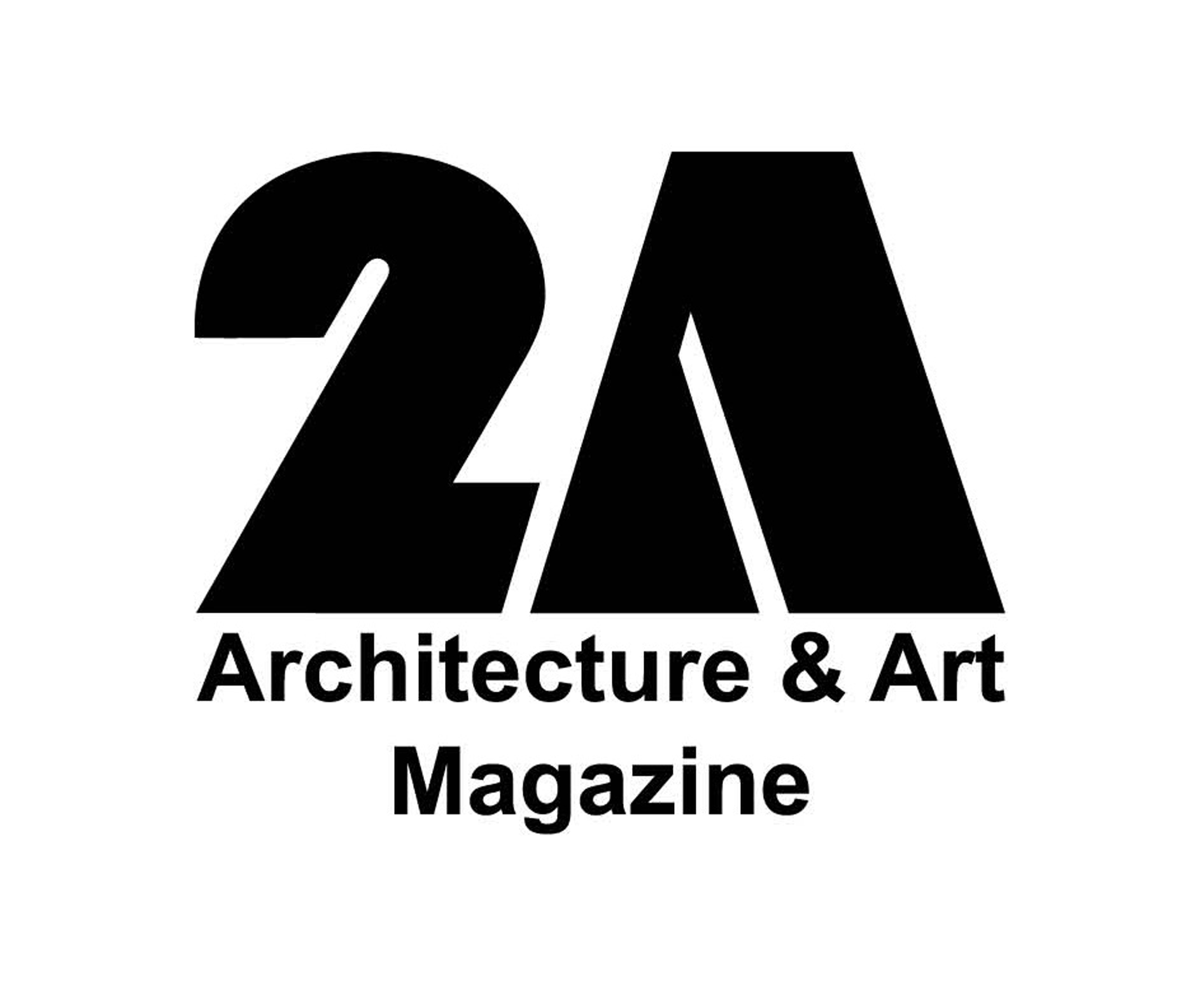
Academic Partner
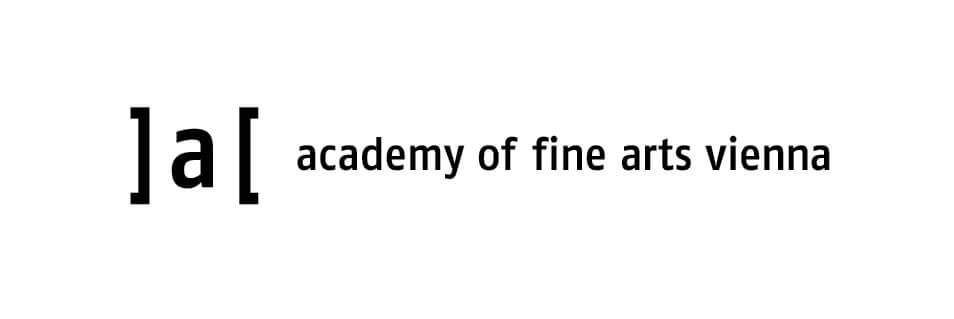
Photo Gallery
